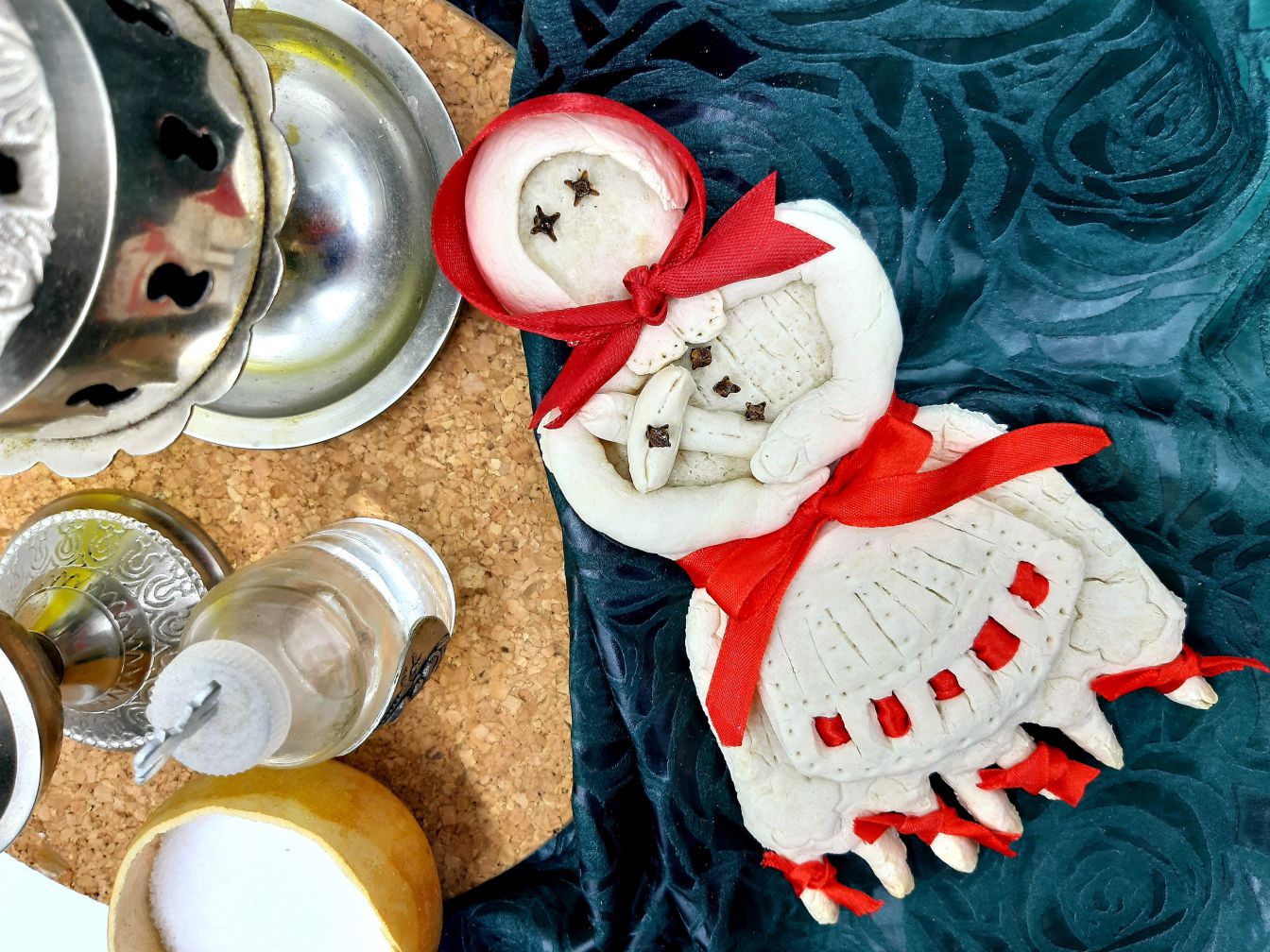Όταν ήμουν παιδάκι ,θυμάμαι την μανούλα μου ,που μας έφτιαχνε την κυρά Σαρακοστή!! Τι χαρά!!! Την έβαζα σε ένα μέρος, και αγωνιωδώς περίμενα να περάσει η βδομάδα να κόψω το ένα ποδαράκι!!!
-Μαμά γιατί 7 ποδαράκια???
-Γιατί θέλουμε 7 βδομάδες μέχρι το Πάσχα!!! 1ο ποδαράκι Κυριακή της Ορθοδοξίας,2ο ποδαράκι Αγ. Γρηγορίου του Παλαμά,3ο ποδαράκι της Σταυροπροσκυνήσεως,4ο ποδαράκι του Αγ Ιωάννη της Κλίμακας, 5ο ποδαράκι της Οσίας Μαρίας της Αιγυπτίας,6ο ποδαράκι την Κυριακή των Βαΐων, και το 7ο ποδαράκι την Κυριακή του Πάσχα!!!!
-Μαμά γιατί δεν έχει στόμα???
-Χωρίς στόμα, να μην κουτσομπολεύει, να μην κρίνει και φυσικά γιατί νηστεύει!!!!!
- Κρατάει και το σταυρό ε?
-Ναι!!! Έχει σταυρωμένα τα χεράκια της γιατί προσεύχεται, και τον σταυρό γιατί πάει εκκλησία!!!
Αναμνήσεις …που έχουν μείνει ανεξίτηλες στην μνήμη μου…που με την σειρά μου, έκανα στην κόρη μου και στον γιό μου κάθε χρόνο.
Σε όλη την Ελλάδα θα συναντήσουμε το έθιμο της κυρά Σαρακοστής. Σε κάποια μέρη την έφτιαχναν από πανί γεμισμένο με πούπουλα, άλλοι πάλι την φτιάχνανε από χαρτί. Στον Πόντο κάναν τον Κουκουρά. Μια πατάτα ή κρεμμύδι κρεμασμένο από το ταβάνι που είχε εφτά φτερά. Και κάθε εβδομάδα βγάζαν ένα φτερό. Κάποιοι πάλι, κάναν με ζυμάρι και κρύβαν μέσα στο ζυμάρι ένα νόμισμα. Όταν έφτανε το Πάσχα και είχαν τελειώσει τα ποδαράκι, κόβαν κομματάκι κομματάκι την κυρά Σαρακοστή. μέχρι να τύχει κάποιος το νόμισμα, όπου θα ήταν και ο τυχερός!!! Σε κάποια μέρη της Ελλάδας, το τελευταίο ποδαράκι το κρύβαν μέσα σε ένα ξερό σύκο μέσα στο καλάθι με τα ξερά σύκα. Αυτός που θα το τύχαινε ήταν και ο τυχερός!
Το ζυμαράκι της κυρά Σαρακοστής φτιάχνεται με αλεύρι αλάτι και νερό. Το αλάτι το βάζουμε γιατί δεν θέλουμε να μας χαλάσει. Προσοχή! Το ζυμαράκι μας αυτό δεν τρώγεται!!! Να κρατήσει της 50 μέρες!
Για την δική μου σαρακοστή έβαλα 300 γρ αλεύρι γοχ ,4 κ σ αλάτι , και 170 γρ νερό. Φτιάχνουμε την σιλουέτα της κυρά Σαρακοστής, της βάζουμε ποδίτσα, σταυρό στο κεφάλι ή στα χεράκια της που είναι σταυρωμένα ,και φυσικά τα εφτά της ποδαράκια. Ψήνουμε για 30’ λεπτά περίπου στους 170ο βαθμούς. Δεν θέλουμε να ψηθεί, αλλά να στεγνώσει.
Το έθιμο λέει ότι όταν φτιάχνεις την κυρά Σαρακοστή, τραγουδάς συνάμα το παραδοσιακό τραγούδι της:
Την κυρά Σαρακοστή που είναι έθιμο παλιό
Οι γιαγιάδες την φτιάχνανε με αλάτι και νερό
Για στολίδι της φορούσαν στο κεφάλι της σταυρό
Και το στόμα το ξεχνούσαν ,γιατί νήστευε καιρό
Και μετρούσαν τις ημέρες με τα πόδια της τα εφτά
Κόβαν ένα την βδομάδα, μέχρι να ‘ρθει η Πασχαλιά
Καλό Πάσχα!!!! Με υγεία!
Mrs. Sarakosti
When I was a child, I remember my mother making us Mrs. Sarakosti! What joy! I would place her in a spot and anxiously wait for the week to pass so I could cut off one of her little legs!
'Mom, why does she have 7 little legs?' 'Because we want 7 weeks until Easter! The 1st leg is on the Sunday of Orthodoxy, the 2nd leg is on St. Gregory Palamas' Day, the 3rd leg is on the Sunday of the Veneration of the Cross, the 4th leg is on St. John Climacus' Day, the 5th leg is on the Day of St. Mary of Egypt, the 6th leg is on Palm Sunday, and the 7th leg is on Easter Sunday!'
'Mom, why doesn't she have a mouth?' 'Without a mouth, she won't gossip, judge, and, of course, because she's fasting!'
'She's holding a cross, right?' 'Yes! Her little hands are crossed because she's praying, and she's also holding the cross because she goes to church!'
Memories... that have left an indelible mark on my memory... that I, in turn, carried on with my daughter and son every year.
Throughout Greece, we encounter the custom of Mrs. Sarakosti. In some places, she was made of cloth filled with feathers, while others made her out of paper. In Pontus, they made 'Koukouras.' It was a potato or an onion hung from the ceiling, having seven wings. And every week, they would remove one wing. Some would make it out of dough and hide a coin inside. When Easter arrived and all the little legs were cut off, they would break Mrs. Sarakosti into small pieces until someone found the coin and became the lucky one! In some parts of Greece, they would hide the last little leg inside a dried fig in the basket with dried figs. Whoever found it would be the lucky one!
The dough for Mrs. Sarakosti is made with flour, salt, and water. We add salt to prevent it from spoiling. Attention! This dough is not meant to be eaten!!! It should last for 50 days!
For my Sarakosti, I used 300 grams of all-purpose flour, 4 teaspoons of salt, and 170 grams of water. We shape the silhouette of Mrs. Sarakosti, give her a little leg, a cross on her head or her crossed little hands, and, of course, her seven little legs. We bake her for about 30 minutes at 170 degrees Celsius. We don't want her to bake, but to dry.
The tradition says that when you make Mrs. Sarakosti, you should sing the traditional song:
Mrs. Sarakosti, an old custom it may be Grandmothers used to make her with salt and water, you see
On her head, she wore a cross, a jewel for all to view Her mouth they forgot to make, as she fasted too
And they counted the days with her seven legs so neat They would cut off one each week until Easter's sweet retreat
Happy Easter! May you be healthy!
ΝΕΕΣ ΣΥΝΤΑΓΕΣ
ΜΕΙΝΕΤΕ ΕΝΗΜΕΡΩΜΕΝΟΙ
Εγγραφή σε newsletter
FEATURED ARTICLE

ΜΕΙΝΕΤΕ ΕΝΗΜΕΡΩΜΕΝΟΙ
Εγγραφή σε newsletter






















































































